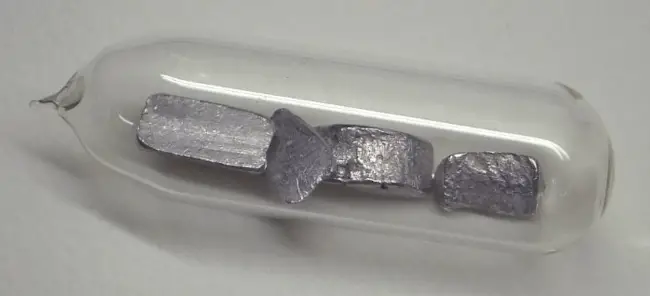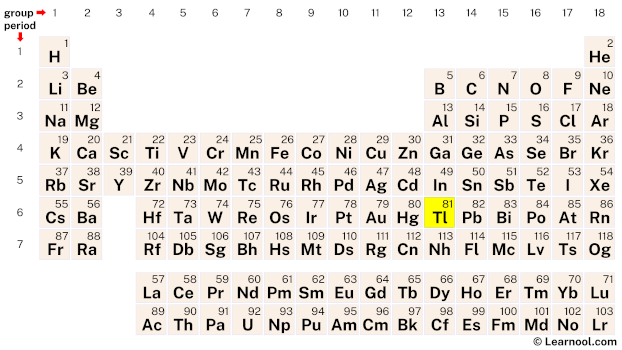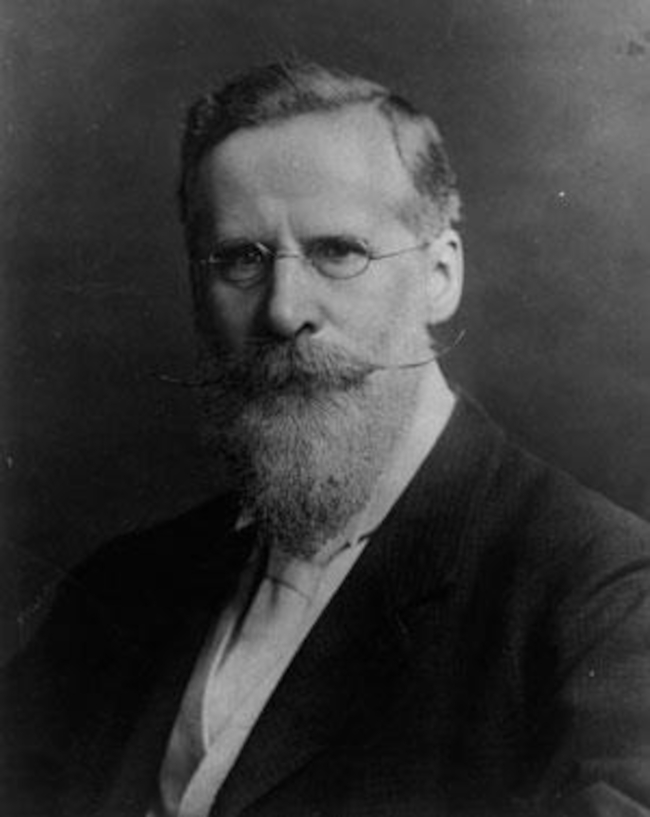
Thallium (Tl) is a chemical element of the periodic table, located in the group 13 and the period 6, and has the atomic number 81. It is a soft, malleable, lustrous, silvery-grey post transition metal, whose name comes from the Greek word “thallos”, which means green twig. It is highly toxic and is not available freely in nature. It is a member of the boron group.
On periodic table
| group | ⇨ | 1 | 2 | 3 | 4 | 5 | 6 | 7 | 8 | 9 | 10 | 11 | 12 | 13 | 14 | 15 | 16 | 17 | 18 |
| period | ⇩ | ||||||||||||||||||
| 1 | 1 H  Hydrogen |
2 He  Helium |
|||||||||||||||||
| 2 | 3 Li  Lithium |
4 Be  Beryllium |
5 B  Boron |
6 C  Carbon |
7 N  Nitrogen |
8 O  Oxygen |
9 F  Fluorine |
10 Ne  Neon |
|||||||||||
| 3 | 11 Na  Sodium |
12 Mg  Magnesium |
13 Al  Aluminium |
14 Si Silicon |
15 P  Phosphorus |
16 S  Sulfur |
17 Cl  Chlorine |
18 Ar  Argon |
|||||||||||
| 4 | 19 K  Potassium |
20 Ca  Calcium |
21 Sc  Scandium |
22 Ti  Titanium |
23 V  Vanadium |
24 Cr  Chromium |
25 Mn  Manganese |
26 Fe  Iron |
27 Co  Cobalt |
28 Ni  Nickel |
29 Cu  Copper |
30 Zn  Zinc |
31 Ga  Gallium |
32 Ge  Germanium |
33 As  Arsenic |
34 Se  Selenium |
35 Br  Bromine |
36 Kr  Krypton |
|
| 5 | 37 Rb  Rubidium |
38 Sr  Strontium |
39 Y  Yttrium |
40 Zr  Zirconium |
41 Nb  Niobium |
42 Mo  Molybdenum |
43 Tc  Technetium |
44 Ru  Ruthenium |
45 Rh  Rhodium |
46 Pd  Palladium |
47 Ag  Silver |
48 Cd  Cadmium |
49 In  Indium |
50 Sn  Tin |
51 Sb  Antimony |
52 Te  Tellurium |
53 I  Iodine |
54 Xe  Xenon |
|
| 6 | 55 Cs  Caesium |
56 Ba  Barium |
72 Hf  Hafnium |
73 Ta  Tantalum |
74 W  Tungsten |
75 Re  Rhenium |
76 Os  Osmium |
77 Ir  Iridium |
78 Pt  Platinum |
79 Au  Gold |
80 Hg  Mercury |
81 Tl Thallium |
82 Pb  Lead |
83 Bi  Bismuth |
84 Po  Polonium |
85 At  Astatine |
86 Rn  Radon |
||
| 7 | 87 Fr  Francium |
88 Ra  Radium |
104 Rf  Rutherfordium |
105 Db  Dubnium |
106 Sg  Seaborgium |
107 Bh  Bohrium |
108 Hs  Hassium |
109 Mt  Meitnerium |
110 Ds  Darmstadtium |
111 Rg  Roentgenium |
112 Cn  Copernicium |
113 Nh  Nihonium |
114 Fl  Flerovium |
115 Mc  Moscovium |
116 Lv  Livermorium |
117 Ts  Tennessine |
118 Og  Oganesson |
||
| 57 La  Lanthanum |
58 Ce  Cerium |
59 Pr  Praseodymium |
60 Nd  Neodymium |
61 Pm  Promethium |
62 Sm  Samarium |
63 Eu  Europium |
64 Gd  Gadolinium |
65 Tb  Terbium |
66 Dy  Dysprosium |
67 Ho  Holmium |
68 Er  Erbium |
69 Tm  Thulium |
70 Yb  Ytterbium |
71 Lu  Lutetium |
|||||
| 89 Ac  Actinium |
90 Th  Thorium |
91 Pa  Protactinium |
92 U  Uranium |
93 Np  Neptunium |
94 Pu  Plutonium |
95 Am  Americium |
96 Cm  Curium |
97 Bk  Berkelium |
98 Cf  Californium |
99 Es  Einsteinium |
100 Fm  Fermium |
101 Md  Mendelevium |
102 No  Nobelium |
103 Lr  Lawrencium |
|||||
| – p block |
Thallium is a p-block element, situated in the thirteenth column (boron group) of the periodic table, below indium (In), and is denoted by the atomic number 81 and chemical symbol Tl.
Element information
 |
|
 |
|
| Origin of name | Greek word “thallos” (which means green twig) |
| Symbol | Tl |
| Atomic number (Z) | 81 |
| Atomic mass | 204.3833 u |
| Block | p-block |
| Group | 13 (boron group) |
| Period | 6 |
| Classification | Post-transition metal |
| Atomic radius | 170 pm |
| Covalent radius | 145±7 pm |
| Van der Waals radius | 196 pm |
| Melting point | 304 ℃, 579 ℉, 577 K |
| Boiling point | 1473 ℃, 2683 ℉, 1746 K |
| Electron configuration | [Xe] 4f14 5d10 6s2 6p1 |
| Electrons per shell | 2, 8, 18, 32, 18, 3 |
| Learn how to draw: Thallium Bohr model | |
| Crystal structure | Hexagonal close-packed (hcp) |
| Phase at r.t | Solid |
| Density near r.t | 11.85 g/cm3 |
| Main isotopes | Thallium-203, Thallium-205 |
| Natural occurrence | Primordial |
| Oxidation state | +1, +3 |
| Electronegativity (Pauling scale) | 1.62 |
| Protons Neutrons Electrons |
81 123 81 |
| Learn how to find: Thallium protons neutrons electrons | |
| Valence electrons | 3 |
| Learn how to find: Thallium valence electrons | |
| CAS number | 7440-28-0 |
| Discovered by | William Crookes in 1861 |
History

Thallium was discovered in 1861 by Sir William Crookes, an English chemist, while he was attempting to extract selenium from the byproducts of sulfuric acid production. Thallium was named after the Greek word “thallos,” which means “a green shoot or twig,” due to the green line in its atomic spectrum.
In the early 20th century, thallium was used as a rodenticide and insecticide. However, it was later discovered to be highly toxic to humans and was banned for these uses. Today, thallium has a few specialized uses in industry, including in the production of optical lenses and as a radiation source in portable X-ray devices.
Occurrence and production
Thallium is a relatively rare element in the Earth’s crust, occurring at an estimated concentration of 0.7 milligrams per kilogram. The primary source of thallium is the minerals crookesite, lorándite and hutchinsonite, although it is also found in small quantities in other sulfide and selenide minerals. Thallium can also be found in some soils, sediments, and waters as a result of human activities such as coal burning, metal smelting, and waste disposal.
Thallium is typically produced as a byproduct of zinc, copper, and lead refining processes, with the majority of production taking place in China. It can also be obtained through the electrolytic deposition of thallium sulfate, or by treating thallium-containing minerals with sulfuric acid. Another method involves the reaction of thallium oxide with hydrogen gas at high temperatures.
The production of thallium is relatively small compared to other metals, with an estimated global production of around 30-40 tonnes per year. However, due to its toxicity, thallium is highly regulated and controlled in many countries, and its use is limited to specific applications such as electronics, pharmaceuticals, and research.
Properties
Thallium is a soft, silvery-white metal that tarnishes quickly when exposed to air.
It has a low melting point of 304 ℃ and a boiling point of 1473 ℃.
Thallium is a highly toxic element that can cause serious health problems even at low exposure levels.
It is a relatively dense element with a density of 11.85 g/cm3.
Thallium is a good conductor of electricity and is used in some electrical devices.
It has two stable isotopes and several radioactive isotopes.
Thallium has some unusual properties, such as its ability to form stable complexes with organic molecules and its tendency to form anions in solution.
Thallium has a unique spectral signature that can be used to identify it in astronomical observations.
Applications
Thallium is a highly toxic element that is not widely used in commercial applications due to its toxicity. However, it has some limited uses in certain fields.
Thallium compounds have been used in medicine as radioisotopes for diagnostic imaging of the heart, lungs, and brain. They are also used in cancer radiation therapy.
Thallium oxide is used as a material for producing glass with a high index of refraction, which is used in lenses for cameras and other optical instruments. Thallium is also used in photocells and as a dopant in semiconductors.
Thallium is used in the production of specialized crystals for use in infrared optics, as well as in the production of specialized glass for use in fiber optics.
Despite its toxicity, thallium has been used as an insecticide and rodenticide. However, its use in these applications has been largely discontinued due to safety concerns.
Thallium is used in the production of certain types of alloys and in the production of high-temperature superconductors. It is also used as a catalyst in certain chemical reactions.
Interesting facts
The name thallium is derived from the Greek word “thallos” which means “a green shoot or twig”.
Thallium has the lowest melting point of any metal.
Thallium is extremely toxic, and its use in rat poison has been banned in many countries.
Thallium can be used in the treatment of ringworm, a fungal infection, and as a contrast agent in medical imaging.
Thallium has been used in the past for homicide and suicide due to its high toxicity and tastelessness.
Thallium is used in the manufacture of high-refractive-index glass for camera lenses, prisms, and spectacles.
Thallium sulfate was once used as a reagent in the detection of potassium ions in biological samples.
Related
More elements
External links
- https://www.rsc.org/periodic-table/element/81/thallium
- https://www.britannica.com/science/thallium
- https://en.wikipedia.org/wiki/Thallium
- https://pubchem.ncbi.nlm.nih.gov/element/Thallium
- https://www.chemicool.com/elements/thallium.html
- https://education.jlab.org/itselemental/ele081.html
- https://www.livescience.com/39303-thallium.html
Deep
Learnool.com was founded by Deep Rana, who is a mechanical engineer by profession and a blogger by passion. He has a good conceptual knowledge on different educational topics and he provides the same on this website. He loves to learn something new everyday and believes that the best utilization of free time is developing a new skill.
